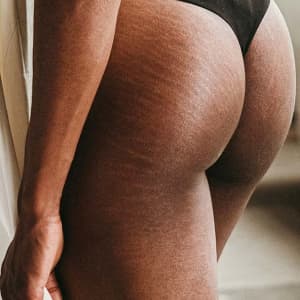 Butt Lift
Butt LiftAre Butt Thread Lifts A Non-Surgical BBL Alternative?
Collagen-stimulating threads may be the newest way to get a booty boost, but are they better than tried-and-true butt enhancement treatments? The experts weigh in.
For celebrities like Jennifer Lopez, the Kardashian sisters, and Beyonce, the idea that bigger is better is true when it comes to the buttocks. From bootylicious backends to perfectly plump and lifted derrieres, the advancements in butt augmentation and contouring continue to grow as patients demand options. “There are a lot of celebrities these days who flaunt full buttocks and fans, naturally, want to get the look,” says Norman Rowe, MD, a board certified plastic and reconstructive surgeon in New York City. “While celebrity surgery inspiration isn’t new, the rate at which social media plays into the popularity of full buttocks is driving demand for buttock-enhancing procedures through the roof.”
One such method that has taken social media by storm? The butt thread lift. This newer, non-surgical treatment option purports to provide more lift and contour, but these dissolvable threads are not necessarily an equal substitute for other long-standing butt augmentation procedures, like butt implants, filler, and the oh-so-popular Brazilian butt lift (BBL), which uses fat to augment the size and shape of the behind.
With many plastic surgeons calling the safety and efficacy of the butt thread lift into question, we decided it was time to investigate the controversial procedure. Here’s what you need to know.
All About Threads
Let’s take a step back for a moment. In general, thread lifts have come and gone, and they are currently back again. In the early 2000s, permanent threads were problematic and posed significant issues, including visible bunching under the skin, perforations, and breakage. These older threads were made of barbed sutures and used firm, unforgiving materials that should have never gone into the face. Case in point: They were said to be so fragile that a simple sneeze could dislodge one.
The threads used today have come a long way. “There is a constant evolution of threads ranging from permanent to absorbable, smooth to barbed, sharp needle insertion to a cannula,” says David Shafer, MD, a board certified plastic and reconstructive surgeon in NYC. Today, both NovaThreads and Silhouette InstaLift, two of the most popular manufacturers of threads for lifts, are approved by the United States Food and Drug Administration (FDA) and far more reliable than past options. These threads (and others) use dissolvable polydioxanone (PDO) and poly-L-lactic acid (the same material used in Sculptra®). “Certainly, the current absorbable barbed threads with cannula insertion are a great leap forward over older generations of threads,” he notes.
Threads are essentially impermanent sutures that give an understated yet visible lift to the skin, but they also have a longer-term effect. Over time, they work “by creating collagen within the skin,” says Paul Jarrod Frank, MD, a board certified cosmetic dermatologist in NYC, which helps to offset the natural decline in collagen production we all experience with age. Most doctors use threads to lift the cheeks and eyebrows and to define the jawline and other facial areas. More recently, threads are being experimented on lifting the breasts, knees, arms, and buttocks. Butt thread lifts make use of threads to create a rounder, shapelier, and more lifted backside.
There is, however, plenty of misinformation about just how much the treatment can accomplish. Instagram videos and images of multiple threads and needles coming out of a person’s face or body can be very dramatic. “Threads give the option for instant results,” Dr. Shafer says. “Unfortunately, there is a misperception by patients — and I think a purposeful deception by some — that threads are equivalent to surgery.” This is simply not the case. “They are not equivalent to what can be accomplished with surgery, especially not in terms of longevity,” he notes.
So while these second-generation dissolvable threads are considered safer and more effective than their predecessors, there is only so much a thread lift can do on any part of the body.
What to Expect from a Butt Thread Lift
Regardless of where on the body threads are used, the details and steps of the procedure are the same. Before the threads (different lengths, sizes, and thicknesses are available based on the treatment area and desired results) are inserted using either needles or cannulas, the area is marked, paying close attention to naturally occurring fat regions.
Next, anesthesia is injected and applied topically to the skin’s surface to make the procedure as comfortable as possible. Then, the threads are inserted under the skin (the thread must pass through the fat that lives between the skin and muscle) and pulled from the insertion point through to the ending point — the threads will act as a scaffolding of sorts.
As with any procedure, the skill of the provider is paramount. To avoid complications, it is important that the threads are not placed too superficially or too deep. Initial results take a few weeks to notice, and the full effect is visible after a few months.
After the first four to six months, the threads will begin to resorb (no need to worry, it’s completely safe). As they break down, collagen forms to add volume that lasts upwards of two years. If you’re not happy with your new booty, the threads can be surgically removed before they dissolve.
Threads vs. Other Butt-Enhancing Procedures
Ever since the rear end became a point of significant focus, women across the globe are taking to butt-enhancing procedures and treatments to increase the size and shape of their back side. Brazilian butt lifts, buttock implants, butt fillers, and butt thread lifts all add volume, but each works differently. Depending on your anatomy and aesthetic goals, some are better options than others. Here’s how all of the popular options stack up:
Brazilian Butt Lift (BBL)
Perhaps the most notorious surgery for creating a dramatically shapelier backside with more projection, BBLs make use of your own fat. “That’s one of the biggest upsides to the procedure — besides more projection — is the removal of unwanted fat via liposuction,” says Finny George, MD, a board certified plastic and reconstructive surgeon in New York. After harvesting the fat from the stomach (or elsewhere), it is purified and spun down (so that only pure fat remains) and then re-injected into the butt. It should be noted that not everyone who wants the procedure is a contender for it. “The ideal candidate is healthy, does not have any clotting or bleeding disorders, has a BMI between 22 and 35, can avoid sitting on their buttocks for two weeks, and has a lack of buttock projection or desires more projection,” Dr. George says.
- The Pros: No use of implants or foreign materials in the body; minimal scars are faint and well-hidden under bathing suits and underwear.
- The Cons: According to Dr. George, the downsides to BBL are bruising, pain, and generalized discomfort. “There is a small risk of developing a blood clot or a fat embolism,” he cautions. “However, your surgeon can mitigate these risks with careful planning and technique.”
Butt Filler
This non-surgical butt enhancement uses biostimulatory fillers like Sculptra®. Injecting Sculptra® off-label into the upper part of the butt creates a rounder, fuller, more lifted derriere. The filler also prompts the body to kickstart its collagen production. “If the patient is thin or does not want surgery, Sculptra® is an excellent alternative,” Dr. George says.
- The Pros: Minimal downtime and recovery
- The Cons: A series of about three treatments spaced several weeks apart is usually required, and the results generally become visible at around six months. Another factor? The price. “Keep in mind that fillers, although great, can be cost-prohibitive,” Dr. Shafer says.
Butt Implants
Silicone butt implants are surgically inserted under the muscle of the butt through an incision in the butt crease to augment its size and shape. These days, many patients opt for filler or BBL over a traditional butt implant because they tend to yield a more natural look.
- The Pros: Silicone implants do not usually rupture or leak
- The Cons: There is a high risk of displacement and infection. “Implants have fallen out of popularity due to their complication profile and revision rate,” Dr. George notes. “As a result, they are not something that I, and many other plastic surgeons, offer.”
The most notable difference between threads used in the buttocks and other butt-improving treatments is that the threads require no harvesting, incisions, or injections. “Unlike other methods, there is no physical addition of volume directly to the area,” Dr. Rowe explains. The tiny collagen-based threads can somewhat lift the skin and, according to Dr. Shafer, help boost the tissue. “Threads may be an option for a very thin patient with slightly loose skin,” he says.
However, just like all other butt-enhancing procedures, threads are not without risk. “The risks are similar to threads used in other parts of the body in terms of depth of placement,” Dr. Shafer shares. “Unintentional superficial placement can lead to visible threads or indentations, while unintentional deep insertion has a higher risk of bruising, pain, and lack of efficacy for the threads.” As he explains, there often is a disconnect between patient expectations and what the threads can achieve. “Once the patients start walking, moving, and pulling, the treads just can’t hold up,” he says. For these reasons, he does not perform thread lifts in the buttocks region.
Are Butt Threads the Way to Go?
Despite all of their attention lately, many doctors do not feel that backside threads are the best option. “In my practice, we use threads on the knees and arms but not on the butt,” Dr. Frank says. “I just don’t see a current option for them in the butt because, in my opinion, they are not thick or strong enough to suspend tissue in that area with that type of weight.” Additionally, the results just aren’t enough. “I don’t think threads significantly lift the tissue or create the amount of collagen development for improvement in the texture and tone like heat and fillers,” he explains.
Seeing as thread lifts have already come a long way, it’s not outside the realm of possibility that they will one day be a reliable butt lift alternative. “As technology and innovation continue, threads or some similar derivative will improve with longer-lasting results, a more dynamic rather than static material, and, hopefully, an enhanced biostimulatory effect to build natural tissue and help rejuvenate aging tissues,” Dr. Shafer says.
The Takeaway
While the butt thread lift is still very new, most doctors feel there is much improvement and fine-tuning needed to make it a viable and comparable enhancement option for all body shapes and types. For those in good shape and at an ideal weight, threads may help smooth and lift the buttocks, but the results won’t last as long as something like a BBL or even filler. For now, a butt thread lift is probably not worth the investment, but that’s not to say all is lost. “Thread technologies may change, and it will probably improve,” Dr. Frank says. “I hope we can use them in the future for greater suspension.”
More Related Articles
Related Procedures

AI Plastic Surgeon™
powered by'Try on' aesthetic procedures and instantly visualize possible results with The AI Plastic Surgeon, our patented 3D aesthetic simulator.


